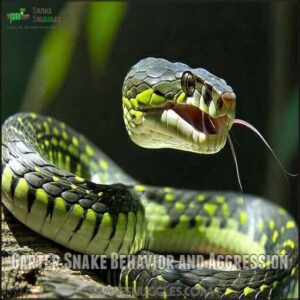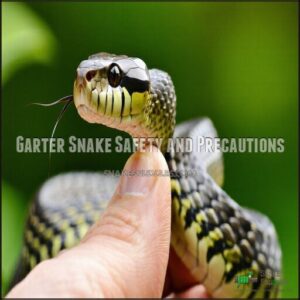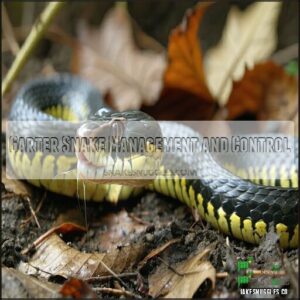This site is supported by our readers. We may earn a commission, at no cost to you, if you purchase through links.
 Yes, garter snakes do have teeth – about 20-30 small, backward-curving teeth in their upper and lower jaws.
Yes, garter snakes do have teeth – about 20-30 small, backward-curving teeth in their upper and lower jaws.
Unlike venomous snakes with fangs, a garter snake’s teeth are more like tiny needles designed for gripping slippery prey like worms and amphibians rather than tearing flesh.
You’ll rarely feel these teeth if handled gently, as they’re typically too small to break human skin.
While technically mildly venomous, their bite poses virtually no threat to humans beyond slight irritation – more like a mosquito bite than anything worthy of concern.
Their dental arrangement is actually a fascinating adaptation for their hunting lifestyle.
Table Of Contents
- Key Takeaways
- Garter Snake Teeth and Venom
- Garter Snake Behavior and Aggression
- Garter Snake Habitat and Distribution
- Garter Snake Diet and Feeding Habits
- Garter Snake Reproduction and Life Cycle
- Garter Snake Safety and Precautions
- Garter Snake Identification and Classification
- Garter Snake Management and Control
- Benefits of Garter Snakes
- Garter Snake Conservation and Protection
- Frequently Asked Questions (FAQs)
- Does a bite from a garter snake hurt?
- Do garter snakes have teeth?
- Will a garter snake bite you if you pick it up?
- Will a garter snake bite my dog?
- Can a garter snake bite hurt a cat?
- Are garter snakes toothless?
- Will garter snakes bite dogs?
- Does a garter snake bite hurt?
- How many teeth does a garter snake have?
- Are garter snakes aggressive?
- Conclusion
Key Takeaways
- Yes, garter snakes have 20-30 small, backward-curving teeth in their upper and lower jaws that help them grip slippery prey like worms and amphibians.
- You’ll rarely feel their teeth if handled gently, as they’re typically too small to break human skin and any bite feels similar to a minor mosquito bite.
- While garter snakes are technically mildly venomous, their venom poses virtually no threat to humans beyond slight irritation at the bite site.
- Garter snakes are beneficial garden residents that help control pests like slugs, insects, and rodents without posing any significant danger to you or your pets.
Garter Snake Teeth and Venom
You’ll be surprised to learn that garter snakes do have 20-30 tiny, backward-curving teeth designed for gripping prey, not for chewing.
They’re also mildly venomous, producing a toxin in their saliva that helps subdue small prey but isn’t dangerous to humans beyond possible minor irritation, which can be considered a minor issue.
Number of Teeth in a Garter Snake
If you’ve ever wondered about a garter snake’s dental situation, you might be surprised by what’s hiding in their mouth. These slender reptiles possess between 20-30 tiny teeth in each jaw, creating an impressive dental arsenal.
Unlike humans, garter snakes continuously replace their teeth throughout life. These small but effective teeth are specially designed for gripping prey rather than chewing food.
- Each tooth features a backward curve (perfect for preventing prey escape)
- Tooth arrangement varies with multiple rows for maximum efficiency
- Dental formulas differ slightly between garter snake species
- Tooth regeneration occurs regularly as teeth wear down or break
- Tooth development continues throughout their lifespan
- Tooth variation exists between front (smaller) and rear (larger) teeth
This snake anatomy adaptation perfectly suits their feeding style – securing slippery prey like worms and small fish before swallowing them whole. The backward curve of each tooth is particularly useful for this purpose.
So yes, these small snake teeth mightn’t be visible at first glance, but they’re certainly there – and remarkably effective! They play a crucial role in the snake’s ability to catch and eat its prey, making them a vital part of the garter snake’s survival mechanism.
Type of Teeth in a Garter Snake
Now that you know how many teeth these slithery creatures have, let’s examine what they’re actually like.
Garter snakes possess very tiny, backward-curving teeth designed specifically for grip rather than cutting. They’re classified as having aglyphous teeth – a simple tooth structure with no specialized fangs for venom injection.
Instead, their tooth arrangement includes small, conical shapes with dental ridges that form sharp edges.
The most distinctive feature? Their rear teeth are slightly larger and connected to Duvernoy’s gland, making them technically "rear-fanged" snakes despite their harmless nature to humans.
How Garter Snakes Use Their Teeth
While most people focus on a garter snake’s slithering movement, it’s their remarkable teeth that truly deserve attention.
These reptiles employ their specialized dental equipment with surprising precision when hunting.
Your garden’s garter snakes use their 20-30 tiny teeth for:
- Gripping prey with backward-curved teeth that act like natural fishhooks
- Securing slippery meals such as worms and frogs without losing their grip
- Facilitating whole-prey swallowing through their flexible jaw mechanics
- Utilizing different tooth arrangements (recurved, curved, and linear) for various prey types
- Creating secure holds through specialized dental ridges with slicing edges
Don’t be fooled by their size – a garter snake’s conical teeth aren’t for chewing but exclusively designed for capture and control.
Their mouth functions as a one-way street: prey goes in but doesn’t come out, thanks to the clever backward orientation of each tooth.
This snake diet adaptation guarantees their hunting success despite their small stature.
Venom in Garter Snakes
Surprisingly, garter snakes do produce venom, contrary to what was long believed.
Contrary to old beliefs, garter snakes actually produce mild venom—a surprising twist in these garden-dwellers’ biology.
Their mild neurotoxin is delivered through enlarged back teeth connected to Duvernoy’s gland, not through hollow fangs like vipers.
This specialized venom delivery system works primarily when they use their snake teeth in a prolonged chewing action.
The venom composition serves an evolutionary purpose – immobilizing small prey like worms, fish, and amphibians.
You’ll find this mild venom in their saliva, making them technically venomous, though harmless to people.
Effects of Garter Snake Venom on Humans
Five important facts about garter snake venom will ease your mind if you’re ever bitten.
Despite having teeth, these snakes produce a mild neurotoxin that’s virtually harmless to humans. When bitten, you’ll typically experience only minor bite irritation—slight swelling, redness, and occasional itching at the site.
The venom potency is extremely low, with no reported systemic effects in humans. In rare cases, some individuals may develop allergic reactions, requiring basic first aid.
Simply wash the area with soap and water to prevent infection. Unlike dangerous serpents, garter snake teeth can’t efficiently deliver their saliva’s mild venom into human skin.
You can appreciate these beneficial garden residents without fear of serious consequences from their bite.
Garter Snake Behavior and Aggression
You’ll find that garter snakes aren’t the aggressive reptiles many people fear, as they typically prefer fleeing over fighting when they encounter humans.
When threatened or cornered, they’ll display defensive behaviors like hissing or releasing a foul-smelling musk rather than immediately striking with their tiny teeth.
Are Garter Snakes Aggressive?
After learning about garter snake teeth, you might wonder about their temperament. Contrary to popular belief, garter snakes aren’t aggressive by nature. These shy reptiles would rather slither away than confront you, using defensive behaviors only when they feel threatened.
When a garter snake feels cornered, you’ll notice these telling reactions:
- They’ll flatten their body to appear larger and more intimidating
- You’ll hear warning hisses as they coil defensively
- They’ll release a foul-smelling musk that’ll make you regret picking them up
- They’ll form an S-shaped posture as their final warning
Temperature substantially affects their temperament—warmer snakes show more active defense mechanisms while cooler ones prioritize escape. Although garter snakes have teeth, their bite frequency is extremely low. Most perceived aggression is actually fear-based reactions, not hostile intent.
Handling effects are minimal if you respect their space.
What Triggers Aggression in Garter Snakes
Garter snakes aren’t naturally aggressive, but they’ve got their limits.
Triggers like rough handling, feeling trapped, or sudden surprises can lead to defensive behaviors. Snake temperament shifts during birthing and mating seasons, too.
For example:
| Trigger | Description | Snake Response |
|---|---|---|
| Handling Stress | Rough touches or picking them up | Could bite or flee |
| Perceived Threats | Feeling cornered or threatened | Releases musk, may bite |
| Environmental Factors | Warm temperatures heighten reactions | Increased defense |
| Seasonal Changes | Birthing season or competition for mates | May show aggression |
Garter snake teeth are tiny but effective for gripping; a bite is harmless but startling! These snakes also rely on pheromone signals and trails for communication.
How to Identify Aggressive Behavior in Garter Snakes
Recognizing aggressive behavior in a garter snake can prevent unnecessary stress—for both you and the snake. These creatures are usually shy, but they’ll give clear signals when they feel unsafe or cornered.
Here’s how to spot their defensive postures:
- S-shaped body coils paired with a raised head, ready to strike.
- Hissing sounds made by forcefully exhaling air, signaling discomfort.
- Rapid tongue flicks showing heightened alertness.
- Body flattening to appear larger and more threatening.
- Open mouth displays, where you might even glimpse their small snake teeth.
- Tail vibrations against surfaces, mimicking a rattlesnake’s warning.
Remember, a garter snake bite is rare and almost always defensive, not aggressive. By understanding these behaviors, you’ll gain confidence in coexisting peacefully with these garden helpers who keep pests at bay.
Defensive Mechanisms of Garter Snakes
Feeling threatened? A garter snake’s arsenal of defense mechanisms might surprise you.
First, they’ll blend in perfectly, using camouflage to vanish like a magician’s assistant. If spotted, they flatten their bodies to look bigger, adding dramatic hissing sounds for effect.
Cornered snakes may rely on a foul-smelling musk release—nature’s way of saying, “Stay back!” And yes, although their tiny garter snake teeth rarely inflict harm, a garter snake bite is still possible.
Clever, huh?
Garter Snake Habitat and Distribution
You’ll often find garter snakes in places with plenty of moisture and food, like grassy fields, wetlands, or even your backyard garden.
They’re incredibly adaptable and thrive across North America, from Canada to Central America, which makes them a common sight.
Common Places to Find Garter Snakes
Ever wonder where those "garden dwellers" like garter snakes hang out?
These adaptable reptiles pop up in a range of habitats. Check out these top five spots:
- Urban Habitats: Suburban yards, especially near rock piles or compost heaps.
- Wetland Areas: Marshes, ponds, and streams—perfect for catching a meal.
- Forest Edges: Where shade meets sunlight, offering shelter and hunting grounds.
- Open Fields: Grassy areas with plenty of ground cover to hide.
- Regional Variations: In Michigan, they thrive near water, moisture, and prey sources.
They’re closer than you think!
Types of Habitats Garter Snakes Prefer
If you’re curious about snake habitats, garter snakes are masters of versatility.
Their preferred homes balance safety, food, and proximity to water. You’ll often spot them basking, hiding, or munching on prey in diverse settings:
- Aquatic Habitats: Marshes, streams, and ponds offer the ideal mix of amphibians and insects.
- Grassy Plains and Forested Areas: Look for them near logs, rocks, and underbrush, where they can hunt and hide.
- Urban Environments: Gardens and compost piles often attract prey, making these spots snake-friendly.
This adaptability is why garter snakes dominate the snake ecology across their impressive range, thriving in almost any regional variation you can imagine.
They can even be found in grasslands, utilizing burrows for shelter.
Geographic Distribution of Garter Snakes
Stretching from chilly Canada to warm Mexico, garter snakes (Thamnophis) showcase remarkable global distribution. These adaptable reptiles conquer various snake habitats, from wetlands to urban settings.
Here’s a breakdown of their regional spread:
| Region | Species | Habitat Preferences |
|---|---|---|
| Northern | Common, Plains | Wetlands, open fields |
| Central | Eastern, Butler’s | Grasslands, streams |
| Southern | Checkered, Blackneck | Arid areas, mountain valleys |
| Coastal Areas | Ribbon, Mexican | Shores, mangroves |
| High Elevations | Northwestern | Mountain valleys, forests |
This diverse geographic distribution highlights how garter snakes thrive across North America, adapting cleverly to local climates, and showcasing their ability to conquer various snake habitats.
Garter Snakes in Michigan
If you’re in Michigan, chances are you’ve encountered one of the state’s three native garter snake species.
Their tiny, curved teeth help them hunt in diverse habitats. Here’s a quick breakdown:
- Eastern garter snakes: Regular visitors to gardens, they help control pests like insects.
- Butler’s garter snakes: Found in wetlands and urban areas throughout the Lower Peninsula.
- Northern ribbon snakes: Preferring wetlands and streams, these sleek snakes thrive in moist environments.
Report sightings at miherpatlas.org to help support conservation efforts!
Garter Snake Diet and Feeding Habits
You might be surprised to learn just how varied a garter snake’s diet is, from slimy worms to slippery fish.
With sharp teeth and a quick strike, they’re efficient hunters that swallow their prey whole.
What Do Garter Snakes Eat?
Garter snakes have an impressively diverse diet, making them adaptable hunters.
Their carnivorous diet includes:
- Frogs, salamanders, and other amphibians.
- Small mammals like mice.
- Fish, insects, and earthworms.
- Slugs, snails, and other mollusks.
- Seasonal prey depending on availability.
Their specialized snake teeth, curved and sharp, guarantee prey immobilization during capture.
Garter snakes don’t chew but rely on swallowing mechanics, consuming prey whole.
This dietary variation plays a vital role in pest control, benefiting gardens while supporting their ecosystem.
How Garter Snakes Hunt and Feed
Garter snakes are impressive hunters, and their methods are as clever as they’re practical.
Their sensory hunting skills let them locate prey with almost unerring accuracy. Imagine this scenario: a garter snake flicks its forked tongue, picking up scent particles like a GPS system for its next meal. Paired with sharp vision, it spots the smallest movement of a frog or worm in its path.
When the time’s right, it strikes quickly, using its backward-curved teeth to grip prey tightly. These teeth work like hooks, making escape nearly impossible.
Once caught, the garter snake uses its flexible jaws and swallowing mechanics to consume prey whole—even meals larger than its head.
Here’s how they hunt:
- Flicking tongues to track prey scents
- Spotting movement with sharp eyesight
- Striking fast to immobilize prey
- Using snake teeth to secure prey
- Engaging strong jaws for ingestion
Types of Prey Garter Snakes Prefer
In terms of prey, garter snakes are nature’s opportunists.
Their snake diet includes worms, insects, amphibians, fish, and even small rodents.
Worm consumption often tops their menu, especially after rain.
Amphibian preference has these snakes targeting frogs and toads near water.
Fish intake is common too, as they ambush prey at water’s edge.
Striking with their specialized snake teeth, they handle insect predation and rodent consumption equally well.
These clever hunters work efficiently, swallowing prey whole and traversing diverse habitats for their next meal.
Importance of Garter Snakes in The Ecosystem
If you’re lucky enough to spot a garter snake in your yard, don’t panic—consider it nature’s little helper!
These harmless snakes play a big role in maintaining ecosystem health, acting as pest control agents while supporting biodiversity. Their diet includes insects, slugs, and rodents, which means fewer pesky garden invaders for you.
Plus, they fit perfectly into the food web as both predator and prey. Garter snakes often employ ambush and stealth to capture their prey.
Here’s why they’re so important:
- Pest control – They naturally manage garden pests without chemicals.
- Biodiversity support – Their presence signals a thriving, balanced habitat.
- Food web balance – Garter snakes are key players in nutrient cycles.
They’re true ecosystem heroes, quietly keeping nature in check.
Garter Snake Reproduction and Life Cycle
You’ll be amazed to discover garter snakes have one of the most fascinating reproductive systems in the reptile world, complete with live births rather than eggs.
While these tooth-bearing creatures hibernate during winter months, they emerge in spring for mating, with females giving birth to 10-40 live young after a gestation period of 2-3 months.
Mating Habits of Garter Snakes
Spring brings an extraordinary spectacle in the snake world.
During reproduction season, you’ll find males following pheromone trails to locate females, using the same teeth that grip prey to now assist in courtship rituals.
These dramatic snake behavior patterns showcase nature’s complex mating habits.
| Behavior | Purpose | Observation |
|---|---|---|
| Mating Balls | Competition | Up to 100 males per female |
| Pheromone Release | Attraction | Chemical communication |
| Sexual Dimorphism | Selection | Females larger than males |
The table highlights the complex mating behaviors, including sexual dimorphism, which play a crucial role in the snake’s reproduction process.
Egg-Laying and Incubation in Garter Snakes
Unlike more common oviparous reptiles, garter snakes practice viviparity, keeping their developing young safely inside their bodies.
This reproductive strategy offers significant advantages in northern climates.
- Females incubate eggs internally for 2-3 months after spring mating
- Litter sizes vary dramatically, ranging from 2 to 80 offspring
- Newborns emerge fully formed with functional teeth for immediate hunting
- No hatchling care occurs – young are completely independent at birth
- Environmental factors like maternal size influence clutch size
This internal incubation system provides perfect temperature control throughout development.
Like boas, garter snakes are commonly bred in captivity as viviparous snake species.
When birth occurs (typically July through October), you’ll find the young already equipped with tiny garter snake teeth, ready to capture their first meal without parental assistance.
Hibernation Habits of Garter Snakes
When winter approaches, garter snakes undertake an amazing survival journey. These reptiles, known for their small, sharp teeth, don’t just hunker down anywhere. Their Den Site Selection is critical—they seek underground spaces like rodent burrows, rock crevices, or tree root systems that maintain temperatures above freezing.
You’ll find them practicing Communal Hibernation, with dozens or even hundreds of snakes tangled together in a sleepy, slow-breathing mass. This snake cuddle puddle helps maintain body heat during their Hibernation Length of 3-5 months.
During this time, their Metabolic Changes are dramatic—heartbeats slow, breathing becomes minimal, and they survive on stored fat reserves. When spring arrives, their Post-Hibernation Behavior includes basking to warm those tiny mouths again!
Life Span of Garter Snakes
Most garter snakes survive only 2-4 years in the wild, though their Average Lifespan extends dramatically in Captivity vs. Wild conditions, reaching up to 10-15 years with proper care.
These slithering creatures face numerous Factors Affecting their longevity, including their small but effective garter snake teeth that help them capture prey.
- Predator Impact substantially reduces survival rates, with hawks, raccoons, and larger snakes constantly hunting them
- Common Diseases like respiratory infections and parasites can shorten their lives
- Environmental stressors including habitat loss and pollution affect their health
You’ll find these snake characteristics fascinating – they’re remarkably resilient despite their relatively brief existence compared to many reptiles.
Garter Snake Safety and Precautions
You’ll want to know how to safely interact with these small-toothed garden visitors, even though garter snakes rarely pose a threat to humans.
While their tiny, backward-curving teeth can grip your skin if provoked, understanding proper handling techniques and bite prevention will guarantee your backyard encounters remain positive experiences.
What to Do if You Encounter a Garter Snake
When you encounter a garter snake, remain calm—these non-venomous snakes are more afraid of you than you’re of them.
Keep a safe distance of at least 3-4 feet, giving them space to retreat. If needed, slowly back away while maintaining visual contact.
Remember, garter snake bites are harmless and extremely rare, only occurring when they’re handled or cornered.
For proper identification, note their distinctive striped pattern before deciding on coexistence or professional removal.
How to Handle a Garter Snake Safely
When approaching a garter snake, remember they’re mostly harmless but can still deliver a defensive bite if they feel threatened.
To handle one safely, use the proper grip technique by supporting its body gently with both hands, never squeezing or grabbing quickly.
For safe handling:
- Start by approaching slowly from the side rather than casting a shadow over the snake, which might trigger its defensive instincts and cause it to strike.
- Keep your fingers away from the head area where those tiny teeth are located, focusing your grip on the middle section instead. For added protection, consider using specialized handling equipment.
Always release the snake promptly and in the same area you found it. Children’s safety around garter snakes requires adult supervision and a calm approach, making bite prevention straightforward. Remember, most defensive bites occur only when snakes feel cornered.
Preventing Garter Snake Bites
Now that you know how to handle garter snakes, let’s focus on avoiding those tiny teeth altogether. While garter snake bites aren’t dangerous, prevention is your best strategy.
You’ll stay bite-free by wearing thick gloves, closed-toe shoes, and long pants during outdoor activities. Never reach blindly under rocks or logs where snakes might rest.
Do Don’t
Remember: most bites happen when snakes feel threatened. Respect their space, and they’ll respect yours.
First Aid for Garter Snake Bites
Should you experience a garter snake bite, prompt first aid can prevent complications.
While these encounters are rarely dangerous, knowing proper care steps guarantees peace of mind.
When dealing with a garter snake bite:
- Clean the wound thoroughly with soap and water, then apply antiseptic to prevent infection
- Monitor for bite symptoms like mild swelling, redness, or itching around the puncture marks
- Apply a cold compress to reduce inflammation and manage any discomfort
- Watch for allergy signs including excessive swelling, difficulty breathing, or hives
- Seek medical attention if unusual symptoms develop or the wound shows signs of infection
Most garter snake bites are merely superficial scratches from their tiny teeth.
Their mild venom isn’t harmful to humans, but proper wound cleaning remains essential. Using a suitable antiseptic product is indispensable for preventing infection.
Remove any jewelry near the bite area as precaution against swelling.
Remember, you’re more likely to get a paper cut than suffer complications from these garden-variety reptiles!
Garter Snake Identification and Classification
You’ll easily recognize garter snakes by their distinctive long, slender bodies with three yellow or white stripes running from head to tail against a dark background.
They’re classified in the Thamnophis genus within the Colubridae family, comprising about 35 species that feature those characteristic stripes and small, backward-curving teeth perfect for gripping prey, which makes them unique among other snakes with distinctive markings.
Physical Characteristics of Garter Snakes
Garter snakes’ physical characteristics make them instantly recognizable in the wild. Their slender bodies typically measure 18-26 inches long, with distinctive scale patterns featuring three light-colored stripes running the length of their bodies.
Color variations include olive green, brown, black, or bluish backgrounds with yellow, white, or cream stripes.
Yes, garter snakes do have teeth! Unlike venomous species, they possess aglyphous teeth—small, backward-curving structures designed for gripping rather than injecting venom. These tiny snake teeth line both upper and lower jaws, helping them secure slippery prey like worms and amphibians.
Their sensory organs are highly developed, particularly their forked tongue that collects scent particles. A lightweight skeletal structure allows for remarkable flexibility and speed when escaping predators.
Despite their intimidating appearance, these adaptations focus on survival rather than aggression—making them fascinating subjects of study rather than creatures to fear.
Types of Garter Snakes
Now that you’ve seen what garter snakes look like, let’s explore the different species you might encounter.
North America hosts several fascinating types of these slithery creatures, each with distinctive traits:
- Common Garter Snake (Thamnophis sirtalis): Features a yellow mid-dorsal stripe and extends from Canada to Costa Rica
- Northwestern Garter Snake (Thamnophis ordinoides): Shows incredible color variations in dorsal stripes, from yellow to red or turquoise
- Western Terrestrial Garter Snake (Thamnophis elegans): Often displays red spotting on its sides
- Plains Garter Snake (Thamnophis radix): Common in Nebraska and southern Alberta
- Red-sided Garter Snake (Thamnophis sirtalis parietalis): Sports a distinctive red-and-black checkerboard pattern
How to Identify a Garter Snake
While many garter snakes share similar features, each species has distinctive markers you’ll want to notice.
Identifying garter snakes requires attention to their physical characteristics:
| Feature | What to Look For | Common Variations |
|---|---|---|
| Color patterns | Longitudinal stripes | Yellow, white, blue, red |
| Scale characteristics | Keeled scales | Slightly rough texture |
| Head shape | Slightly wider than neck | Oval or rounded |
| Body size | 18-36 inches long | Thinner than garden hose |
| Stripe variations | Three primary stripes | Sometimes checkered pattern |
They’re not toothy predators, but garter snake teeth do exist—tiny and backward-pointing for gripping slippery prey. Garter snakes have distinctive markers and physical characteristics that are important to notice, including their color patterns and scale characteristics.
Differences Between Garter Snakes and Other Snakes
Slithering through your garden, garter snakes differ dramatically from their serpent cousins in several key ways.
Unlike other snakes with prominent fangs, garter snakes possess small, backward-curving teeth designed for gripping rather than killing.
Four shocking differences that’ll make you shiver:
- Tooth structure: Garter snakes have 20-30 tiny teeth versus venomous fangs
- Venom comparison: They produce mild neurotoxin versus deadly venom
- Diet differences: They target small prey like worms versus larger mammals
- Behavior contrasts: They’re non-aggressive garden helpers versus ambush predators
Their unique dentition and habitat variations make garters beneficial neighbors, not threatening foes—something to appreciate next time you spot one, and understand their role as non-aggressive garden helpers with mild neurotoxin and small prey preferences.
Garter Snake Management and Control
You’ll find it’s much easier to manage garter snakes on your property once you understand their habits and what attracts them.
While these small-toothed creatures aren’t typically dangerous, knowing effective control methods can help you maintain a snake-free home without harming these beneficial pest controllers.
How to Remove a Garter Snake From Your Home
Finding a garter snake in your home can startle even the bravest homeowners, but with three simple steps, you can handle safe removal without breaking a sweat.
First, remain calm—these harmless reptiles aren’t looking for trouble. When approaching snake relocation, always wear thick gloves and have a container ready for capture. Move slowly and deliberately to avoid triggering the snake’s defensive instincts.
For successful removal, keep these tools handy:
- A broom to gently guide the snake
- A large plastic bin with a secure lid
- A snake hook for careful handling
- A pillowcase as an alternative capture method
If you’re uncomfortable with DIY removal, don’t hesitate to call professional help. Consider using specialized handling gear for added safety. Experts specialize in humane relocation techniques that guarantee both your safety and the snake’s wellbeing.
Remember, garter snakes actually benefit your garden by controlling pests—they just took a wrong turn into your living space!
Preventing Garter Snakes From Entering Your Home
Anyone can prevent garter snakes from entering their home with proper exclusion methods. Start by sealing entry points—fill cracks wider than 1/4 inch, repair door gaps, and secure foundation openings with fine metal mesh.
The effectiveness of different exclusion techniques can be summarized as follows:
| Exclusion Technique | Effectiveness | Cost |
|---|---|---|
| Sealing cracks | Very high | Low |
| Metal mesh barriers | High | Medium |
| Weather stripping | Moderate | Low |
Regular yard maintenance keeps these harmless visitors at bay. Trim tall grass, remove debris piles, and maintain a 2-3 foot vegetation-free perimeter around your foundation.
For additional protection, snake repellents containing clove oil or sulfur compounds can be used, though results vary. For persistent problems, don’t hesitate to seek professional help—they’ll identify hidden entry points you might’ve missed.
Garter Snake Control Methods
Now that you’ve sealed entry points, let’s explore effective control methods for these toothy visitors.
Control garter snakes with these practical approaches:
- Create natural barriers using lemongrass or marigolds—snakes hate their scent
- Modify their habitat by removing debris piles and keeping grass short
- Consider catch-and-release traps for humane removal without harm
Professional removal services offer expertise when DIY methods fall short. While garter snakes have small, backward-curving teeth, they’re beneficial predators that help control pests naturally. Exclusion methods work better than chemical repellents for long-term success, and using humane removal techniques is important.
Humane Treatment of Garter Snakes
Compassion guides humane treatment of garter snakes, as these harmless reptiles deserve our respect. When you need to relocate one, remember that ethical relocation starts with safe handling—wear gloves to protect from their tiny teeth and support their entire body to minimize stress.
Habitat preservation matters for their survival and your garden’s health. Gently guide unwanted snakes to nearby natural areas, and they’ll continue their important ecological work—just not in your basement!
- Your heart will lighten knowing you’ve protected a beneficial creature that controls pests naturally
- You’ll feel relief seeing them thrive in an appropriate habitat rather than suffering in captivity
- Your conscience stays clear by choosing responsible observation over unnecessary harm
Benefits of Garter Snakes
You’ll appreciate having these toothy garden allies around when you notice fewer slugs, mice, and insects destroying your prized vegetable patch.
Their efficient hunting skills and varied diet of common garden pests make them one of the most beneficial natural pest controllers you can welcome into your yard.
Role of Garter Snakes in The Ecosystem
Year after year, garter snakes quietly maintain ecosystem health through their valuable contributions.
These reptiles form a vital link in the food web, controlling populations of insects, slugs, and small rodents. You’ll find their diet directly impacts biodiversity, as they prevent any single prey species from dominating the environment.
Their presence affects population dynamics of various organisms, creating balance throughout the ecosystem. While small in size, their predation activities ripple through the entire natural community, supporting overall health and stability in ways you might never notice, ultimately contributing to ecosystem health.
Importance of Garter Snakes in Pest Control
Garter snakes frequently serve as nature’s pest control experts in your garden, working tirelessly to keep unwanted visitors at bay.
These beneficial reptiles help maintain balanced ecosystems through their natural hunting abilities.
When you welcome garter snakes in your yard, you gain three significant benefits:
- They consume destructive insects, slugs, and worms that damage plants
- They reduce the need for chemical pesticides, supporting sustainable pest management
- They help control small rodent populations that might otherwise multiply unchecked
With their specialized teeth and hunting instincts, garter snakes contribute to garden ecosystem health by naturally managing pest populations.
Their presence creates a more balanced wildlife community, making them valuable allies in your quest for natural pest control without harmful chemicals.
How Garter Snakes Help The Environment
While often overlooked, garter snakes serve as nature’s environmental champions beyond mere pest control.
You’ll find these harmless reptiles maintaining ecosystem balance by controlling rodent and insect populations that would otherwise explode unchecked.
They’re essential biodiversity supporters, helping maintain soil health through nutrient cycling when consuming and digesting prey.
As indicator species, their presence signals a healthy ecosystem, and next time you spot one in your garden, remember: it’s not just a snake—it’s an environmental ally with a crucial role in ecosystem balance.
Interesting Facts About Garter Snakes
Beyond helping control pests, garter snakes boast fascinating characteristics that might surprise you.
Did you know these slithery creatures possess small, backward-curved teeth (not fangs) perfectly designed for gripping slippery prey?
You’ll never see them chewing—they swallow meals whole!
While they do produce mild venom through specialized glands, don’t worry—a garter snake bite won’t harm you beyond minor irritation.
Their unique scale patterns and color variations make each snake distinct, with some sporting vibrant stripes in yellow, red, or blue.
Other interesting garter snake facts include:
- They shed their skin several times yearly as they grow
- Their enhanced senses include detecting prey through smell and vibration
- During winter, they hibernate in massive groups called "snake balls"
- When threatened, they release a foul-smelling musk that’ll make you recoil
Garter Snake Conservation and Protection
You’ll find these toothy garden helpers facing threats from habitat loss and pesticide use, despite their valuable role in controlling pests with those small, backward-curving teeth we’ve discussed.
While you’re learning about their dental adaptations for catching prey, don’t forget you can create snake-friendly spaces in your yard by providing shelter and avoiding chemicals that harm these beneficial reptiles.
Threats to Garter Snake Populations
Garter snakes face mounting threats in their natural environments.
Habitat loss remains the primary concern, with urbanization and development fragmenting their territories and reducing population connectivity.
Climate change compounds these issues by altering precipitation patterns and increasing extreme weather events that directly impact their aquatic habitats.
Invasive species pose a significant danger, with non-native bullfrogs and fish becoming major predators.
These unwelcome guests compete for resources while directly preying on snake populations.
Human activities worsen the situation, with urban development destroying habitats and agricultural practices altering essential riparian zones.
Environmental contaminants from agricultural runoff introduce another layer of risk, while the emerging threat of Snake Fungal Disease further endangers populations.
These multiple stressors don’t operate in isolation—they work synergistically, creating a perfect storm that threatens garter snake survival across their range, due to habitat loss, climate change, and invasive species.
Conservation Efforts for Garter Snakes
While threats to garter snakes grow, conservation efforts have gained momentum across North America. You can make a real difference with simple actions that protect these beneficial reptiles.
Conservation work doesn’t require specialized knowledge—just commitment to preserving biodiversity. Here’s how you can contribute to garter snake conservation:
- Habitat preservation: Protect natural vegetation and water sources on your property
- Reducing pesticide use: Switch to organic gardening methods that won’t harm snakes
- Public education: Share facts about garter snakes’ ecological benefits with neighbors
- Protecting wetlands: Support local initiatives to restore and maintain wetland areas
- Climate change adaptation: Plant native species that provide shade and shelter
- Genetic diversity protection: Avoid relocating snakes between distant areas
- Invasive species control: Remove non-native plants that disrupt natural habitats
- Community science: Report sightings to wildlife agencies for population monitoring
The checkered garter snake is protected in Georgia. Through these efforts, you’re not just saving snakes—you’re helping maintain healthy ecosystems for all creatures, including humans, which is crucial for conservation and supports the overall environmental balance.
Protected Areas for Garter Snakes
Building on successful conservation initiatives, protected areas serve as essential sanctuaries for garter snake populations.
Wildlife reserves, national parks, and eco sanctuaries create safe havens where these beneficial reptiles can thrive undisturbed. These conservation zones shield garter snakes from habitat destruction, pollution, and human encroachment—threats that have diminished their numbers in many regions.
Well-managed wetlands within these areas support the small fish and amphibians that garter snakes depend on for food. Many protected sites also incorporate population monitoring programs to track ecosystem health and the effectiveness of preservation efforts.
You’ll find dedicated garter snake conservation projects in national parks across North America, which are often part of broader conservation initiatives and support the overall ecosystem.
How to Help Protect Garter Snakes
While protected areas offer sanctuary for garter snakes, your everyday actions can substantially boost their survival.
Here’s how you can contribute to garter snake conservation without special training:
- Create microhabitats: Install rock piles, native plants, and log sections in your yard. These simple additions provide essential shelter and basking spots, supporting habitat preservation when wild spaces are scarce.
- Practice responsible gardening: Reduce pesticides in your lawn and garden. These chemicals harm pests as well as garter snakes and their food sources, disrupting the entire ecosystem.
- Spread knowledge: Share facts about these beneficial reptiles with neighbors and friends. Misconceptions often lead to unnecessary fear and snake deaths.
- Join community efforts: Participate in local wildlife conservation initiatives or report snake sightings to research programs. Your observations help scientists track population changes and develop effective conservation strategies.
Every small step you take helps maintain our natural balance!
Frequently Asked Questions (FAQs)
Does a bite from a garter snake hurt?
What doesn’t kill you makes you wiser!
A garter snake bite usually feels like tiny pin pricks that barely hurt.
You’ll feel mild discomfort, minor swelling, or itching, but it’s rarely serious.
Do garter snakes have teeth?
Yes, garter snakes do have teeth – about 20-30 tiny, backward-curving ones that help them grip slippery prey.
You’ll notice they’re arranged in multiple rows, but they’re not designed for chewing.
Will a garter snake bite you if you pick it up?
Garter snakes can bite but they rarely do.
They’re shy, not aggressive. If you handle one gently, it’ll likely try to escape first.
When cornered or roughly grabbed, they might bite defensively.
Will a garter snake bite my dog?
While garter snakes can bite your dog if they feel threatened, their tiny teeth usually cause minimal harm.
They’re mildly venomous, but the venom isn’t dangerous to dogs, typically resulting in only minor irritation.
Can a garter snake bite hurt a cat?
While garter snakes do have tiny teeth, their bite typically won’t harm your cat beyond minor irritation.
The mild venom isn’t dangerous to cats, though the bite might cause slight swelling or temporary discomfort.
Are garter snakes toothless?
Contrary to popular belief, these slithery garden visitors aren’t shy about flashing their pearly whites.
You’ll find they’re equipped with 20-30 tiny, backward-curving teeth designed for gripping prey, not for chewing.
Will garter snakes bite dogs?
While uncommon, garter snakes can bite dogs if they feel threatened.
Their small teeth might cause minor irritation but won’t cause serious harm.
You should still clean any bite wound as a precaution.
Does a garter snake bite hurt?
A storm in a teacup best describes a garter snake bite.
You’ll feel a slight pinch with tiny puncture marks.
It’s not painful and rarely causes more than minor redness or itching, which can be considered a slight pinch.
How many teeth does a garter snake have?
You’ll find a garter snake has 20-30 tiny, backward-curving teeth arranged in multiple rows on both jaws. They’re perfectly sized for gripping slippery prey, not for chewing their meals.
Are garter snakes aggressive?
Peace prevails in the garden kingdom of garter snakes.
You’ll find these slithery neighbors aren’t aggressive at all.
They prefer fleeing to fighting when you approach, only biting if cornered or roughly handled.
Conclusion
Now you know the truth about garter snake teeth like the back of your hand.
While these harmless garden visitors do have teeth, they’re tiny and rarely break skin.
Understanding does a garter snake have teeth helps appreciate these beneficial creatures that control pests in your yard.
- https://www.jstor.org/stable/3891690?seq=1
- https://www.nytimes.com/2005/04/05/science/open-wide-decoding-the-secrets-of-venom.html
- https://animaldiversity.org/accounts/Thamnophis_sirtalis/
- https://www.michigan.gov/dnr/0,4570,7-350--61219--,00.html
- http://www.herprman.com/species/snakes/butlers-garter-snake






















